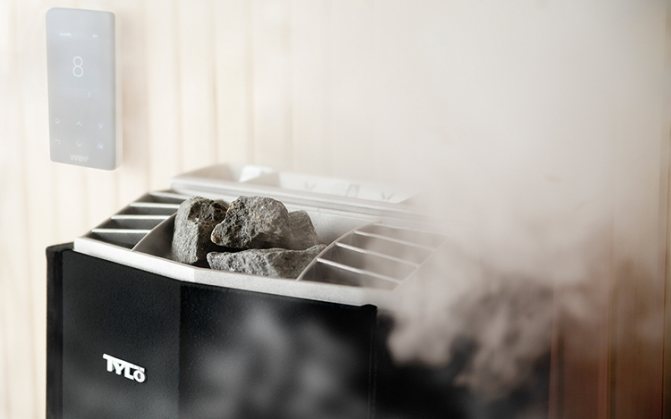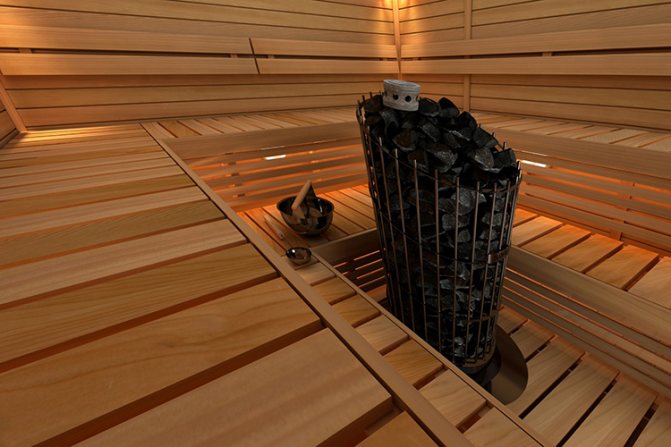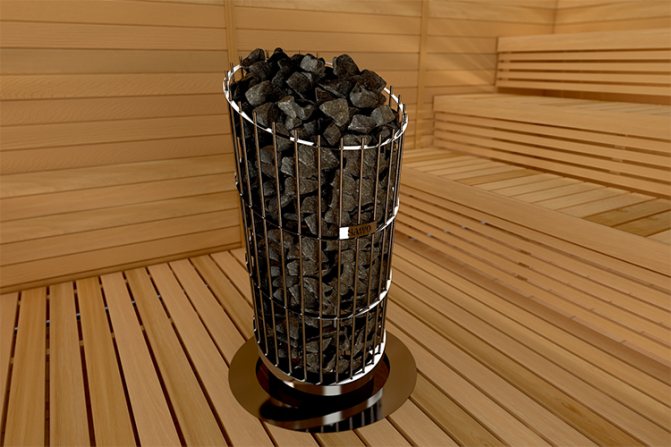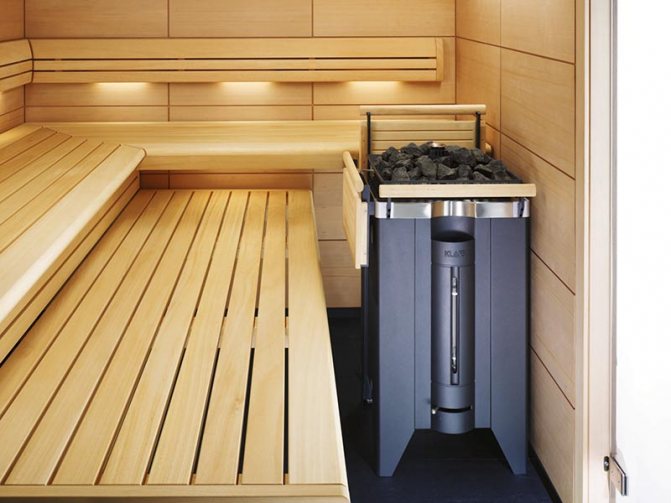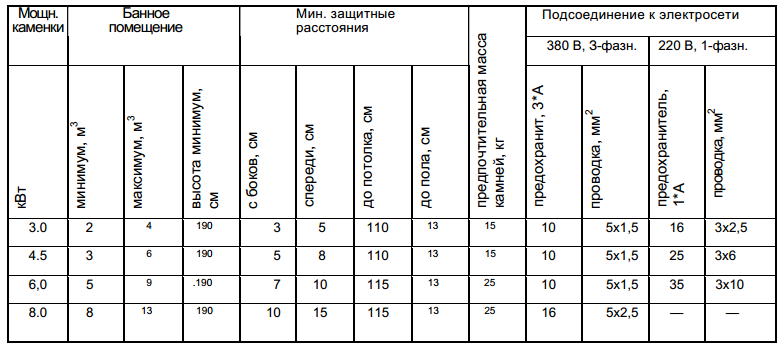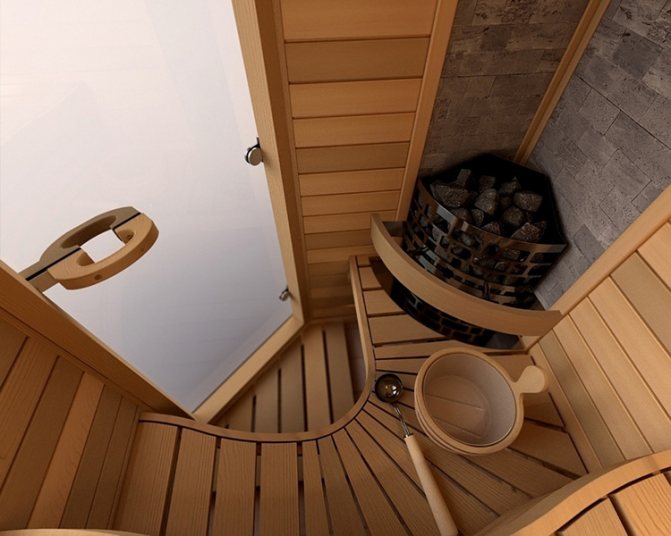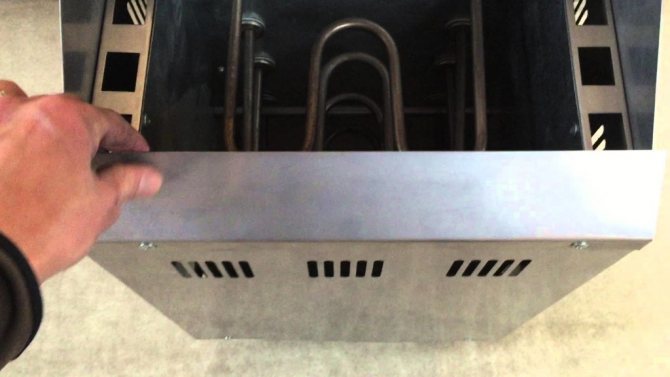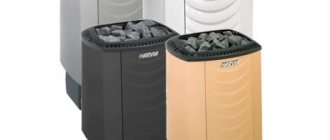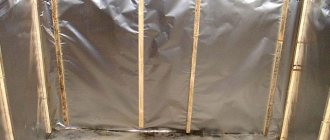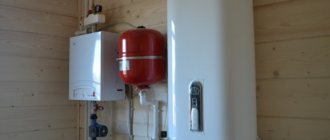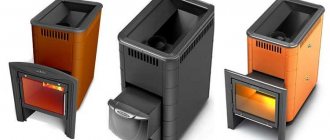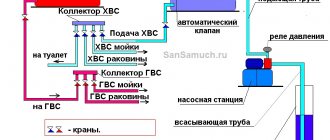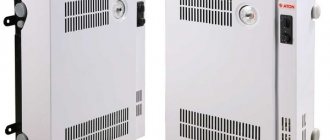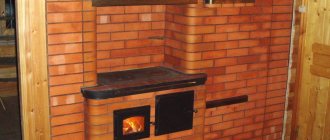The wonderful feeling that we experience after visiting the sauna cannot be replaced by anything! Inspiration combined with tranquility - it's worth going to the sauna just for this. Especially when there is an electric sauna at home.
The steam room is presented in the form of an equipped room with an integral electric stove-heater. An electric sauna is installed both in public places and at home. The absence of an open source of flame allows installing an electric sauna cabin even in an apartment. With the help of an electric heater, the room heats up very quickly.
The principle of an electric sauna cabin
The design of the steam room is so simple that it is assembled with several working tools and fasteners. A saw, a hammer (screwdriver) and nails (screws) are the key to half the success, and you can even cope with the installation alone.
Installation materials
The sauna room is made of wood. Slats are sewn onto a frame made of timber and a wooden lining is attached to them. The decorative elements of the cladding are aspen, cedar, or pine wood. The outside can also be sheathed with compressed wood.
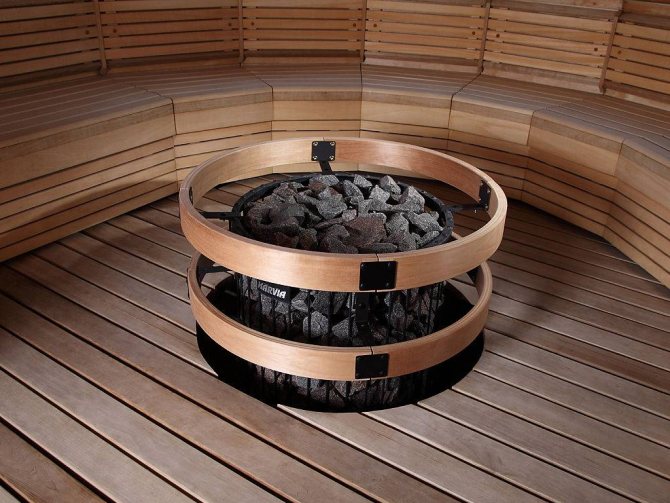
It is advised to carry out all the decoration from wood in the steam room - walls, ceiling, and even benches. For the latter, the best option is abasha wood with low thermal conductivity.
As for the steam room door, it is also made of wood, with a gap of 2-3 centimeters to the floor - for full air circulation. For safety reasons, the sauna door must only open outward!
Steam room air exchange
As for the sources of ventilation, there should be two of them in an electric sauna - a supply one and an air outlet. The hole size is small. Some people prefer forced air exchange with built-in electrical forced ventilation. But, in the presence of a normally functioning natural system, fans are impractical, unless only for quick drying of the electric sauna cabin after use.
An important parameter of the cabin
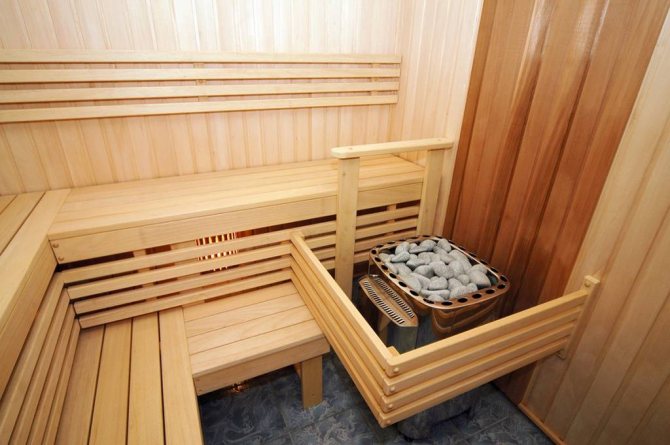

Maintaining the correct temperature / humidity ratio in an electric sauna is imperative. In it, the temperature of the upper layers of human skin reaches the maximum permissible +50 degrees Celsius, but such a temperature can be tolerated only when the air mass is stationary. The sharp currents of hot air in a dry sauna will cause burns on the body. In order to prevent intense convection, the room of an electric steam room is made no higher than 2.1 meters - then the humidity of the sweat secreted by the skin is enough to cool the body.
Thermal insulation
An electric sauna is installed indoors at a distance of at least 5 centimeters from the wall to avoid condensation and the formation of mold or mildew.
Walls and ceilings made of wood are insulated with mineral wool, fiberglass or cork insulation. Tightness must be observed in everything, including the door to the electric sauna cabin. Maximum thermal insulation is achieved by a three-stage door leaf. The glass door is treated around the perimeter with a silicone seal.
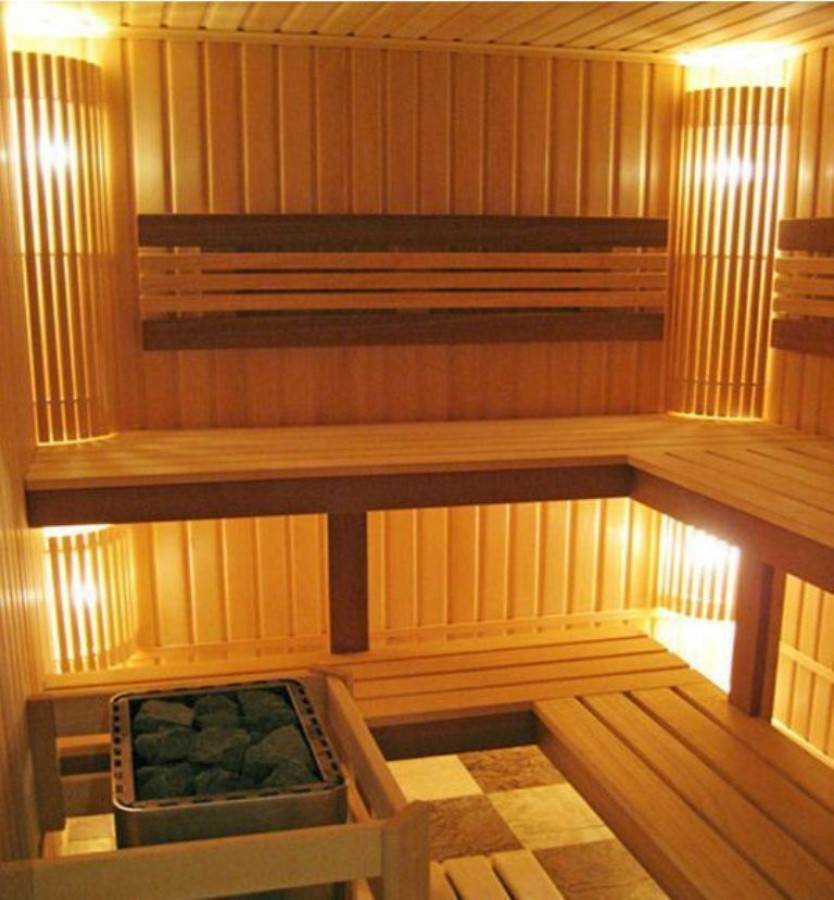

Light in the steam room
High temperature and humidity in the room excludes bright lighting. Electric light should be dim and diffused (light bulbs up to 60 W). Better that the light source is not visible, place it either on top or under the benches.
Lamps must be used heat-resistant.
Why choose an electrician?
Nowadays, it is really easier to build an electric heater than to heat a stove with wood. Because it:
- Clean - no ash on the floor near the firebox and blower, there is no need to get your hands dirty to light the fireplace;
- Fast - start and heat up the oven, this process does not take much time;
- Safe - the likelihood of getting burned is minimized. There is also no risk of gas leakage, explosion, the likelihood of a fire is significantly reduced;
- Convenient - using a modern control panel, it will not be difficult to set any specified parameters;
What is true, you will only have to come to terms with the high costs of electricity, so if you are ready for them, move on.
What do you need to manually assemble a stove?
Gathered to create do-it-yourself electric oven for a bath
- it is necessary to select a thermal heating element (TEN). It is also worth deciding what type of oven will be, open or closed. Usually, the second option is chosen more often, since the heating element in it can be installed in any position. In addition to the heater, you will need a screen and a bus for the voltage wire.
Assembling the sauna heater
When starting to work with electricity, it is necessary to familiarize yourself in detail with the construction and technical instructions, check the equipment and use a protective suit. When assembling do-it-yourself electric ovens for a bath
be sure to observe grounding, and also at the first start-up, check the resistance so that it falls within the range of 3-5 ohms.
From what to make the body and what size it should be, you decide, based on the volume of the room that needs to be heated. Usually sheet steel is chosen, the stove can be made open trellised or closed. Installation of equipment from pre-purchased or welded elements is as follows:
- First, the number of heating elements is determined, based on the cubic capacity of the bath room;
- The heating elements are connected to each other using a jumper system;
- A heat shield is made of sheet steel;
- The stove is welded and laid out.
Advice: it is better to choose stones from river, flat - they are sold in finished form in hardware stores.
- The frame is assembled from metal sheets. The electric oven can also be laid out with bricks.
- The electrical circuit is sequentially assembled and a control relay is installed. Rotary switches are usually chosen.
Done, the oven can be plugged in and, after checking all the parameters, enjoy a new quick heat-up steam room.
(Visited 6,043 times, 1 visits today)
Despite the fact that many bath lovers remain devoted to traditional stoves in the yards, electric analogs of stoves are becoming more and more popular every day. The so-called stove can be bought and built with your own hands, and in both cases it will work much more efficiently and heat the bath faster. Among other things, an electric heater is more comfortable than a conventional stove, and its installation is not difficult. What kind of heaters are there and how to connect a sauna stove yourself?
Heating device for electric sauna
The electric sauna is characterized by maximum safety, simplicity and ease of use. The temperature regime is easily set using the electronic control, the set temperature and humidity are maintained automatically.
The operating principle of the oven is convection. The heater is capable of heating the air up to 80-95 degrees Celsius in an hour. The built-in heating element heats up the stones, which are placed in a specially designed compartment of the furnace.
The heating element is reliably protected from moisture. It does not burn oxygen like infrared heaters, the heat from it is distributed more evenly and the effect is softer.
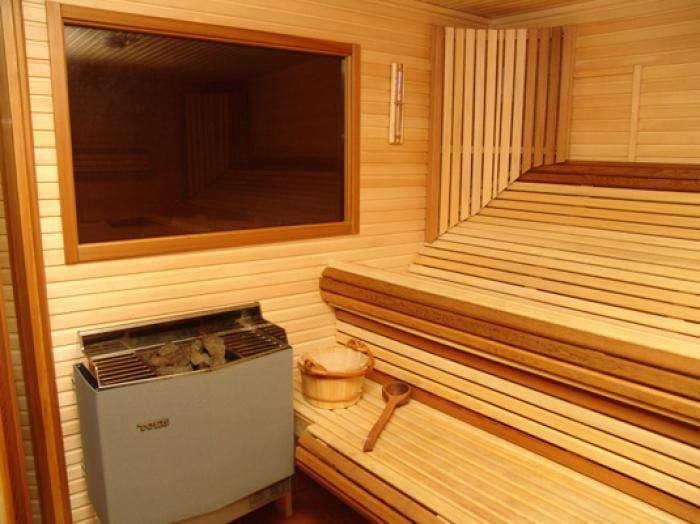

The stove body is usually made of metal. A well-made stove does not heat up the outer casing, and you cannot burn yourself on it.
Sauna stones
An electric sauna needs special stones, which are placed in the gap between the heating elements as tightly as possible, but leaving space for air circulation.
Not all stones will fit - a heat-resistant structure is required. The temperature of the impact on the stones is very high, and ordinary stones can crack and even injure a person. Also, they should not emit harmful substances.
It is strictly forbidden to lay stones with a smooth surface and cracks. Only on an uneven structure is water retained and evenly evaporated.
The following stones are ideal for an electric heater:
- jade;
- volcanic peridotite;
- chipped talcochlorite;
- Scandinavian diabase;
- Karelian gabbro-diabase.
From time to time it is necessary to revise the stones in the furnace - to replace the broken and used ones for a long time. It is recommended to sort out stones according to the scheme: the frequency of bruising stones (per year) is equal to the frequency of visiting the sauna (per week). That is, if the sauna is operated every day, then once every couple of months the stones need to be sorted out.
Installing a stone oven
The device is extremely simple to operate: it is connected to the mains, turns on, and the room starts to warm up. After reaching the required microclimate in the room, the heater automatically maintains the set temperature level.
Installation of the stove is elementary, but requires compliance with safety regulations. It is worth reading the instructions carefully. It contains simple rules that an inexperienced user will not always think about. For example, that you cannot install the stove on the aisle (you can get burned), or that you need to bring a three-phase network.
Advantages and disadvantages
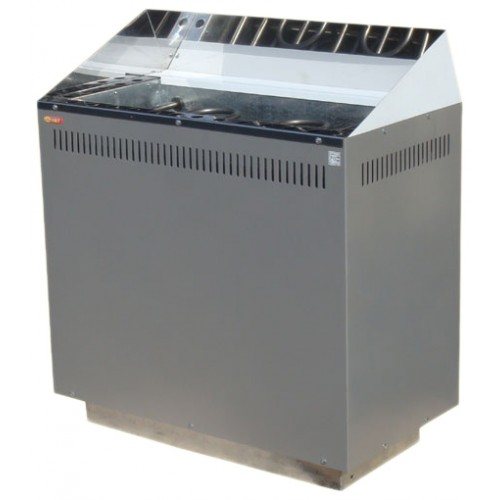

The positive aspects of electric sauna stoves are:
- The combination of rapid heating of the steam room and the ability to maintain the required temperature for a long time.
- Small size.
- Possibility of self-installation of such stoves. Unlike gas stoves for a bath, permission from the gas service for installation is not required.
- There is no need to store fuel by placing it in the bathhouse, the stoves operate from a conventional 220 or 380 volt electrical network.
- An electric oven for a Russian bath does not require a smoke exhaust duct, this simplifies installation.
- It does not require cleaning from soot, periodic maintenance.
- Easy setting of the required temperature regime of the oven.
- Thanks to the automation, unwanted overheating is eliminated.
- Such a stove does not emit carbon dioxide, it is safe for human life.
- The electric sauna stove has good thermal protection, minimizing the possibility of ignition of the wooden elements of the steam room.
At the same time, it is worth highlighting the disadvantages of such electrical units:
- The high cost of its maintenance, electric energy is a rather expensive type of fuel, and such furnaces are very energy-intensive installations.
- Often, for powerful electric furnaces, there is not enough electrical wiring resource, which is designed for a lower consumed load.
- Heat generation in electric ovens is lower than that of gas or wood-fired heating sauna stoves.
Heater electrical requirements, power
The general principle for calculating the power of a sauna stove is as follows: one kilowatt of energy is enough for 1 m3 of room volume. Usually, about 30% of the power is added to the resulting indicator, so that the electric oven will last longer and probably cope with its function.
Electric heaters up to 8 kW are connected to a 220 V network, while high-power ones (from 9 kW) require a three-phase network (380 V). This applies to saunas with a volume of 12 m3 or more - they require 9 or more kW, and a heater of such power is connected only to a three-phase network.
We make an electric heater with our own hands (video)
Thus, an electric heater is a modern analogue of a wooden sauna stove.An electric oven works more efficiently, faster and is much more comfortable to use. You can either buy a ready-made model or make a stove with your own hands, since it is not difficult at all. To make a stove, you need heating elements, heating elements powered by the mains, as well as metal, stones and possibly bricks to make a protective wall.
Giving preference to the stove-heater, it is necessary to choose the right place for it, as well as think over its appearance. At this stage, it is recommended to identify the main benefits of such sauna stoves
.
Features of electric heaters
When choosing an electric stove for a sauna, you need to clarify the following points:
- power sufficient to heat the room;
- heater dimensions;
- maximum amount of loaded stones;
- execution (corner, wall, floor, for installation in the center);
- type of control panel (built-in, remote);
- the presence of a steam generator;
- layering and quality of the metal body;
- the presence of overheating fuses.
Case execution
Depending on the location of the electric furnace, floor and wall mountings are performed:
- floor-standing - equipped with a powerful heating element up to 30 kW and a volume of loaded stones up to 240 kilograms, often installed in the center of a large room, without additional preparation;
- wall-mounted - low power within 9 kW, mounted on the wall, over the decorative sheathing. A wall oven can hold no more than 30 kilograms of stones.
